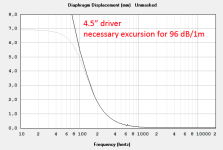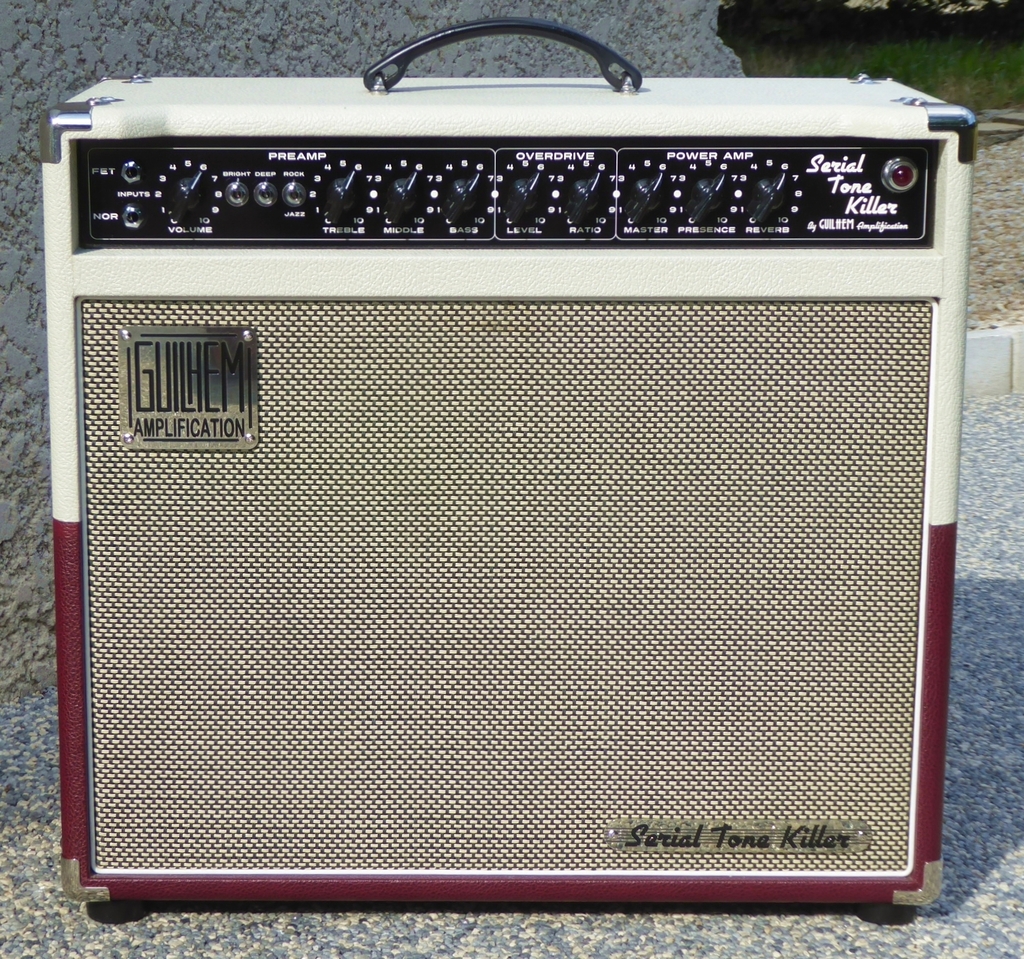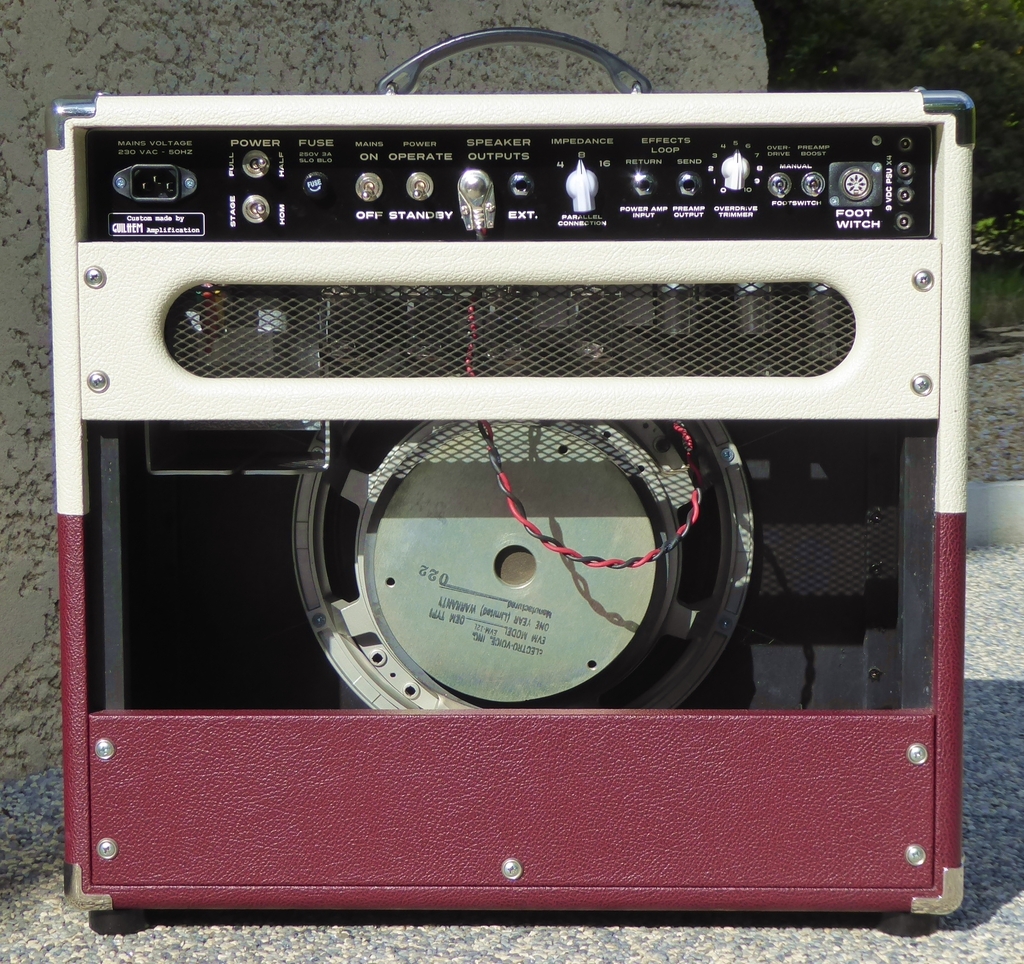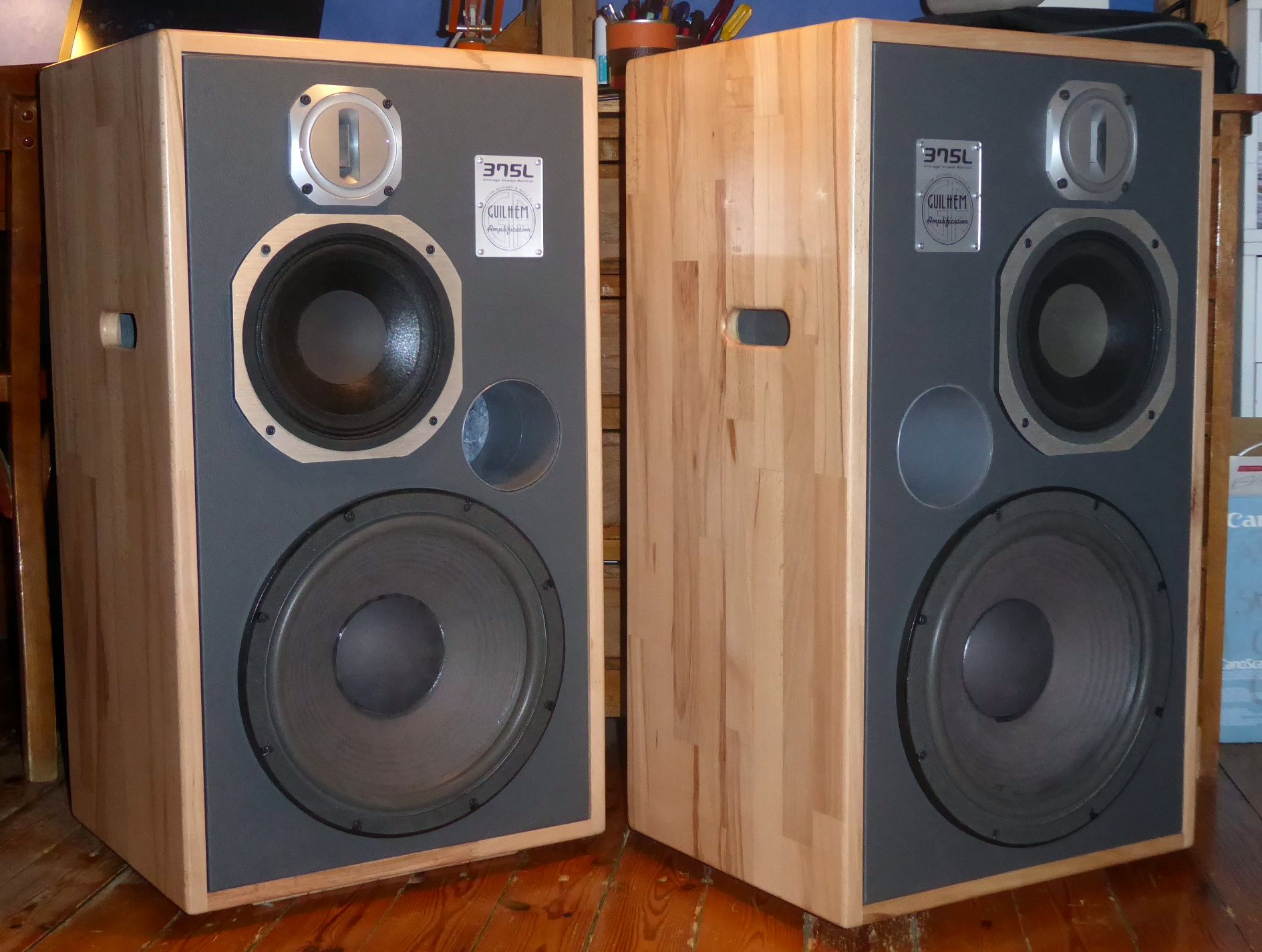There is no compromise, on the contrary: midbass drivers need much more excursion, so the a) voice coil or b) the magnet gap needs to be long, which leads to compromises.What's the compromise they're making?
a) sacrifises efficiency and increases inductance
b) is expensive and heavy.
Physical reason is that half a frequency needs quadruple the volume displacement for the same SPL which leads to quicly diminishing necessary excursion as frequency goes up (that's the case for midrange drivers).
Not sure what you mean here, more excursion compared to what? I asked about midranges, not midbass
I mean:Not sure what you mean here
for a midbass you need lots of excursion and you have to compromise to achieve that.
for a midrange you need very small excursion and you can get away with less compromises.
A midrange crossed over low and/or with very high SPL requirements needs some excursion capabilities, however.
edit:
here is a necessary excursion graph for a small 4.5" driver delivering 96 dB/1m SPL.

(the light grey line at the bottom end is due to the actual driver's rolloff)
Last edited:
Required excursion drops four-fold for each octave so not much excursion is needed.Why are most midranges limited in linear excursion, by the way? What's the compromise they're making?
One goal for good sound for a midrange is low moving mass so trying to have a larger xmax will impair sound quality.
That is one reason to use underhung voice coils. You do not need to power handling and you want to have lower moving mass.
Not sure about that...@lrisbo did a paper that talks, among other things, about transducer moving mass.One goal for good sound for a midrange is low moving mass so trying to have a larger xmax will impair sound quality.
"Basically, what we’re saying is that fundamentally, moving mass only affects sensitivity, while what folks call “fast” or “slow” amounts to bandwidth. And that does not relate to mass, but mostly to how real cones flex and spring back when you push on them. How much depends on material type and geometry but not directly on mass.
A case in point: diamond tweeter domes are fabled for their “speed”, i.e. bandwidth, but as it happens, they are also the heaviest domes in regular use. This is reflected in diamond tweeters’ lower than average efficiency. But even though diamond domes are much heavier than their aluminum counterparts, they’re much, much stiffer too."
https://purifi-audio.com/blog/tech-notes-1/a-fast-driver-needs-a-light-cone-or-does-it-6
So does moving mass affect sound quality? I'm not sure 🤔 (I don't pretend having the answer either, just to be clear! )
Last edited:
for a midrange you need very small excursion and you can get away with less compromises.
Of course, but what's the benefit of NOT having a flat BL(x) other than maybe cost?Required excursion drops four-fold for each octave so not much excursion is needed.
I can't think of anything that would be a benefit, except maybe for a more gradual increase of distorsion (guitar speakers?) when approaching Xlin.what's the benefit of NOT having a flat BL(x)
can't think of anything that would be a benefit, except maybe for a more gradual increase of distorsion (guitar speakers?) when approaching Xlin.
This may be a possible explanation why such speakers like the EVM12L are not so favoured usually by guitar players... 🤔 😉
T
Well, Electric Jazz players love them, and others use them with Semi-Acoustics. When you play complex chords you don't want additional IMD and "wolf tones" at stage volumes ;-)This may be a possible explanation why such speakers like the EVM12L are not so favoured usually by guitar players... 🤔 😉
To first order, added mass simply drops SPL output for frequencies sufficiently above resonance which is shifted down unless the suspension is stiffened.So does moving mass affect sound quality? I'm not sure 🤔
Looking at the details, we find that internal feedback factor around resonance is reduced (assuming standard voltage drive) and that could slightly change the distortion profile for better or worse.
As long as you stay reasonable, say, varying moving mass from 0.7x to 1.4x (for a 2:1 range) of a certain design value I wouldn't expect any significant differences -- other than from the cone/dome itself -- unless it's been a junk driver to begin with.
Hello All,
I have a kind of dual view of the world of midrange drivers:
Smaller stand size speakers for "nearfield listening" and
Full size speakers for indulgent lounging on the couch listening.
For stand size speakers Purifi drivers measure the best, as in lowest HD and IMD.
For full size speakers my favorite mid drivers are 10 inch JBL2123H's, JBL 2118H"s are not bad either. At the same listening position SPL levels the 10 inch JBL's test much the same as the 6 1/2 inch Purifi drivers.
Thanks DT
Measurements are made with APx555 analyzer, APx1701 transducer test amplifier and GRAS microphones.
I have a kind of dual view of the world of midrange drivers:
Smaller stand size speakers for "nearfield listening" and
Full size speakers for indulgent lounging on the couch listening.
For stand size speakers Purifi drivers measure the best, as in lowest HD and IMD.
For full size speakers my favorite mid drivers are 10 inch JBL2123H's, JBL 2118H"s are not bad either. At the same listening position SPL levels the 10 inch JBL's test much the same as the 6 1/2 inch Purifi drivers.
Thanks DT
Measurements are made with APx555 analyzer, APx1701 transducer test amplifier and GRAS microphones.
Well, Electric Jazz players love them, and others use them with Semi-Acoustics. When you play complex chords you don't want additional IMD and "wolf tones" at stage volumes ;-)
Yes. One of my DIY guitar amps uses an EVM12L :


T
For the midranges, I tend to prefer large ones for a matter of tone balance. Below I use a Beyma 8" 8M60N midrange, covering the 400-5000Hz range :

Here are its specs and parameters :


T

Here are its specs and parameters :
T
Not everyone it seems. It is true, as Charles pointed out the terminology is misleading.The Xlin and Xmax terms may be confusing, but no one in his right mind in this thread is interested in mechanical Xmax: everybody here means Xmax lin when Xmax is referred to. That context is clear as crystal, in particular because of the Bl(x) discussion.
I read interesting things, some facts, some not so much fact. And I'm learning a bit. Just enough to keep interested. Again the variations are only at driver extreme displacement. And how audible is this is terms of real world use? Masking effects will dominate. And at these excursion extremes the eddy currents and the resulting distortion are the dominant factors.
Suspension creep being the fantasy thought. Not real. If it was you would have drivers that would never have stable Thiele Small parameters. There was a time 30 plus years ago when the phenolic resin on the damper would need to be broken in. But that is long past being a reality if you have a quality damper?spider supplier.
Here you are...
I did, quite a few times. The reality is : IMD on Vifa/Peerless TC9, 1450 & 1550, sweeping up from ~55 dB SPL to 100 dB SPL and back.
View attachment 1333825
Go figure out how to explain it🙂
BTW, You may want to read the publications of Pascal Brunet, PhD , Research Director of Samsung Audio Lab
I do like the inverted V exitation SPL. That is the ideal plot/setting to examine DC-Displacement.
best regards,
Bernd
I must confess I still do not grasp the set up for the inverted V excitation SPL, as Hornli named the setup.
Mikets42: could you be a bit more specific about the test set up and stimuli applied?
Mikets42: could you be a bit more specific about the test set up and stimuli applied?
D
Deleted member 375592
Hi Boden,
It's a usual setup with a condenser mic calibrated by a measurement mic.
It is set so that a sinewave at -25dBFS produces 80dB SPL @1m, and mic gain is set up to record the same -25dBFS. Then you provide the stimuli as a tone (or a dual tone) going up and down in amplitude (a kind of AM). You can use Matlab script I gave a few pages ago. Then you process the result using STFT (aka Gabor). The result must be symmetric if the things are proper. You need to troubleshoot whenever the result is not symmetric, which may require a PhD🙂
AFAIK, standard tools do not support this type of measurement. Matlab / Octave - easy.
It's a usual setup with a condenser mic calibrated by a measurement mic.
It is set so that a sinewave at -25dBFS produces 80dB SPL @1m, and mic gain is set up to record the same -25dBFS. Then you provide the stimuli as a tone (or a dual tone) going up and down in amplitude (a kind of AM). You can use Matlab script I gave a few pages ago. Then you process the result using STFT (aka Gabor). The result must be symmetric if the things are proper. You need to troubleshoot whenever the result is not symmetric, which may require a PhD🙂
AFAIK, standard tools do not support this type of measurement. Matlab / Octave - easy.
- Home
- Loudspeakers
- Multi-Way
- The importance of Kms(X) and BL(x) for mid-ranges